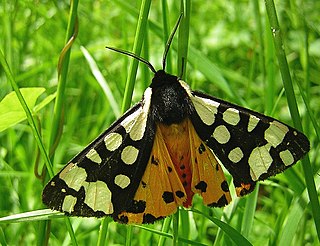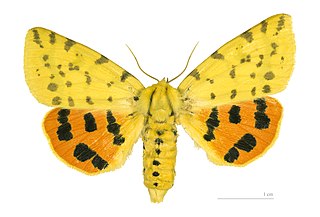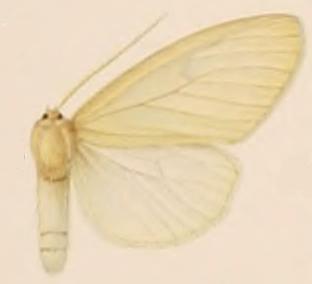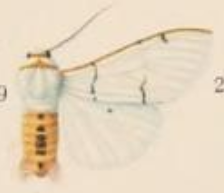
The Arctiina are a subtribe of moths in the family Erebidae.

Diacrisia is a genus of tiger moths in the family Erebidae. The genus was erected by Jacob Hübner in 1819. Its species can be found in Europe and Asia.

Diacrisia sannio, the clouded buff, is a moth of the family Erebidae. The species was first described by Carl Linnaeus in his 1758 10th edition of Systema Naturae. It is found in the Palearctic realm from Ireland to Siberia. It is not found in North Africa. In the Russian Far East, eastern China, Korea, and Japan it is replaced by Diacrisia irene.

Diacrisia purpurata, the purple tiger, is a moth of the subfamily Arctiinae. The species was first described by Carl Linnaeus in his 1758 10th edition of Systema Naturae. It is found in Europe, Anatolia, Syria, Transcaucasus, Central Asia, southern Siberia, Mongolia, Amur Region, northern China, Korea and Japan (Honshu).
Hollowayana is a genus of tiger moths in the family Erebidae. The genus contains only one species, Hollowayana landaca, which is found in Java, Bali, and Flores.

"Diacrisia" porthesioides is a moth of the family Erebidae. It is found in Sikkim.
Amerila cinyra is a moth of the subfamily Arctiinae. It was described by Muller in 1980. It is found in Africa.
Amerila mulleri is a moth of the subfamily Arctiinae. It was described by Christoph L. Häuser and Michael Boppré in 1997. It is found in the Democratic Republic of the Congo, Kenya, Eswatini and Zimbabwe.
Amerila phaedra is a moth of the subfamily Arctiinae. It was described by Weymer in 1892. It is found in Kenya, Mozambique, Tanzania and Zimbabwe.
Amerila lucida is a nomen nudum moth taxon of the subfamily Arctiinae. It was described from Africa by Muller in 1980.
Amerila myrrha is a nomen nudum moth taxon of the subfamily Arctiinae. It was described from Africa by Muller in 1980.
Diacrisia aurapsa is a moth of the family Erebidae. It was described by Robert Swinhoe in 1905. It is found on Saparua in Indonesia.
Diacrisia echo is a moth of the family Erebidae. It was described by Walter Rothschild in 1910. It is found in Asia.

Spilosoma curvilinea is a species of moth of the family Erebidae. It was described by Francis Walker in 1855. It is found in Cameroon, Republic of the Congo, Democratic Republic of the Congo, Ghana, Ivory Coast, Kenya, Nigeria, Senegal, Sierra Leone, Sudan, Tanzania, the Gambia and Uganda.

Diacrisia metelkana is a moth in the family Erebidae. It was described by Julius Lederer in 1861. It is found in southern and central Europe, Russia, eastern Asia and Japan.
Diacrisia nebulosa is a moth in the family Erebidae. It was described by Arthur Gardiner Butler in 1877. It is found in the Russian Far East, China, Japan and possibly Korea.
Diacrisia subvaria is a moth in the family Erebidae.
Diacrisia amurensis is a moth in the family Erebidae. It was described by Otto Vasilievich Bremer in 1861. It is found in the Russian Far East, China, Korea and Japan.

Spilosoma buryi is a moth in the family Erebidae. It was described by Walter Rothschild in 1910. It is found in Ghana and Nigeria.
Spilosoma latipennis, the pink-legged tiger moth, or the red-legged diacrisia, is a moth in the family Erebidae. It was described by Richard Harper Stretch in 1872. It is found in eastern North America, where it has been recorded from Georgia, Indiana, Iowa, Kansas, Kentucky, Maine, Maryland, New Brunswick, New York, North Carolina, Ohio, Ontario, Pennsylvania, South Carolina, West Virginia and Wisconsin.





